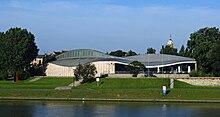Arata Isozaki
You can help expand this article with text translated from the corresponding article in Japanese. (July 2011) Click [show] for important translation instructions.
|


Arata Isozaki (磯崎 新, Isozaki Arata; born 23 July 1931) is a Japanese architect from Ōita. He graduated from the University of Tokyo in 1954.
Isozaki worked under Kenzo Tange before establishing his own firm in 1963. His early projects were influenced by European experiences with a style mixed between "New Brutalism" & "Metabolist Architecture" (Oita Medical Hall, 1959-1960) according to Reyner Banham. His style continued to evolve with buildings such as the Fujimi Country Club (1973–74) and Kitakyushu Central Library (1973–74). Later he developed a more modernistic style with buildings such as the Art Tower of Mito (1986–90) and Domus-Casa del Hombre (1991-1995).
Isozaki has designed buildings both inside and outside Japan. He is considered one of world's most illustrious architects, having won multiple international awards.
In 2005, Arata Isozaki founded the Italian branch of his office, Arata Isozaki & Andrea Maffei Associates. Two major projects from this office are currently underway: CityLife office tower, a redevelopment project in the former trade fair area in Milan, and the new Town Library in Maranello, Italy.[1]
Awards[2]
- Annual Prize, Architectural Institute of Japan in 1974
- Mainichi Art Award in 1983
- RIBA Gold Medal in 1986
- International Award “Architecture in Stone” in 1987
- ArnoldW.BrunnerMemorial Prize of the American Academy and Institute of Arts and Letters in 1988
- Chicago Architecture Award in 1990
- Honor Award, the American Institute of Architects in 1992
- RIBA Honorary Fellow in 1994.
- The ECC Award in 2012 for his Venice installation Zhongyuan.[3][4]
Notable works
- Ōita Prefectural Library, (1962-1966) Ōita, Ōita, Japan
- Kitakyushu Municipal Museum of Art (1972-1974) Fukuoka, Japan
- KitaKyushu central library (1973-1974) Fukuoka, Japan
- Museum of Contemporary Art (MOCA), (1981-1986) Los Angeles, California, United States
- Sports Hall for the 1992 Summer Olympics, (1983-1990) Barcelona, Spain
- Ochanomizu Square Building - Casals Hall, (1984-1987) Tokyo, Japan
- Art Tower Mito, Mito, (1986-1990) Ibaraki, Japan
- Team Disney Orlando, (1987-1991) Florida, United States
- Bond University, - Library, Administration Building, Faculty of Humanities Building (1987-1989) Gold Coast, Australia
- KitaKyushu International Conference Center (1987-1990) Fukuoka, Japan
- Palau Sant Jordi (1990) Barcelona, Spain
- Palafolls Sports Complex Pavilion, (1987-1996) Barcelona, Spain
- Centre of Japanese Art and Technology, (1990-1994) Kraków, Poland
- Kyoto Concert Hall, (1991-1995) Kyoto, Japan
- Nara Centennial Hall, (1992-1998) Nara, Japan
- Domus Casa Del Hombre, (1993-1995) A Coruña, Galicia, Spain
- Nagi Museum Of Contemporary Art, (1994) Nagi, Okayama, Japan
- Shizuoka Convention and Arts Center GRANSHIP, (1998)
- COSI Columbus, (1994-1999) Columbus, Ohio, United States
- Shenzhen Cultural Center, (1998-2007) Shenzhen, China
- New entrance of the CaixaForum Barcelona building, (1999-2002) Barcelona, Spain
- Isozaki Atea, (1999-2009) Bilbao, Spain
- Torino Palasport Olimpico, (2000-2006) Turin, Italy
- Museum of the Central Academy of Fine Arts in Beijing, (2003-2008) China
- New Concert Hall Building, (2003-) Thessaloniki, Greece, 2010
- Himalayas Center, (2003-) Shanghai, China
- Diamond Island, (2006-) Ho Chi Minh City, Vietnam (complete in 2012)
- Coliseum da Coruña, A Coruña, Galicia, Spain, 1991
- Weill Cornell Medical College in Qatar, Education City, near Doha
- Weill Cornell Medical College in Qatar, opened 2004
- Metropolis Thao Dien, Ho Chi Minh City, Vietnam (under construction)
- The new Town Library in Maranello (2012), Italy (Arata Isozaki and Andrea Maffei)
Current projects
- CityLife office tower (Il Dritto), Milan, Italy (Arata Isozaki and Andrea Maffei)
- The University of Central Asia's three campuses in Tekeli, Kazakhstan; Naryn, the Kyrgyz Republic; and Khorog, Tajikistan
- The New exit for the Uffizi Gallery, Florence, Italy - competition winner (Arata Isozaki and Andrea Maffei)
- The renovation of the Bologna Centrale railway station, Bologna, Italy - competition winner
References
- ^ Musei: Architetture 1990-2000. ISBN 978-8871791999.
- ^ Musei: Architetture 1990-2000. ISBN 978-8871791999.
- ^ "ECC AWARD". www.europeanculturalcentre.eu. Retrieved 2017-07-11.
- ^ "Time-Space-Existence in Venice". www.world-architects.com. Retrieved 2017-07-11.
External links
- Arata Isozaki & associates
- Arata Isozaki at the Museum of Modern Art
- Corkill, Edan. "Arata Isozaki: Astonishing by design". Japan Times, 1 June 2008.
- Sarah F. Maclaren, “Arata Isozaki e la fine dell’utopia”, in “Il senso della fine”, Ágalma. Rivista di studi culturali e di estetica, 19, 2009: 61-75. ISSN 1723-0284.
- CityLife Official website of the project
- Liddell, Colin. "Arata Isozaki: Solaris". Metropolis, 23 January 2014.
